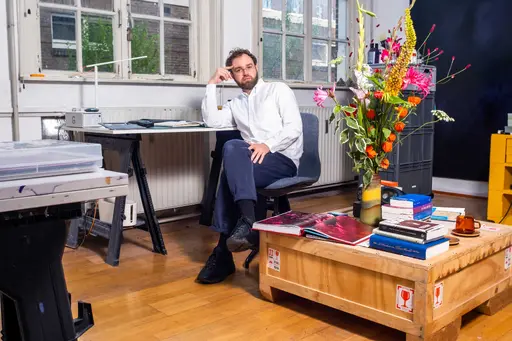output – interview
From the online publication "Fellows Published 2021-2022"
Jason Hendrik Hansma was one of the nine fellows in the academic year 2021-2022. The interview below is published in the online publication “Fellows Published” that was launched in November 2023.
fellowspublished.rietveldacademie.nl
fellowspublished.rietveldacademie.nl
Jason Hendrik Hansma is an artist whose work explores the in-between, the liminal, and the nearly articulate. Within the fellowship, Hansma has been working on the idea of translation as an art practice, along with Benjamin's concept of 'over-naming' that occurs as the very basis of language. Hansma has been thinking of tools that counteract 'over-naming', especially through climate change which stands to undo our linguistic and material boundaries. These ideas have informed films, exhibitions, and a general studio attitude.
What was the starting point of your research project?
It started with the idea of translation as an art practice and philosopher Walter Benjamin’s concept of “over-naming,” which occurs as the very foundation of language. I've been thinking about tools to combat over-naming, particularly as climate change threatens to undo our linguistic and material boundaries. This concept has influenced films, exhibitions, and my overall studio attitude in recent months.
What approach did you take for the fellowship research project, and how does it relate to the role of research in your practice?
My approach has been to investigate the material consequences of language. I primarily accomplished this investigation through Benjamin’s concept of over-naming, which he introduced in his 1916 essay “On Language as Such, and on the Language of Man.” He sees this concept as a way for us to “name” to solidify our own framework to control language and subjects. But, in doing so, we also break the possibilities of plurality. Because of my past disability, I've considered the linguistic slur as a way of undoing the “over-name” and as a decategorizing power to which other non-linguistic languages, such as music, could be added.
I'm also using the concept of “The Slur” to disrupt the consolidation of language around climate change. According to Benjamin, things communicate primarily through a “material community,” from which we cannot escape by over-naming. In response to this, I’ve been researching and compiling a collection of moving embers, smoke, and ash from around the world, as well as the fires that produce them. These films are based on manual scraping of online amateur video sources informed by tags and metadata syntax. The collections feel more like “flow throughs” of participation with an “un-nameable” climate crisis, or, as Benjamin would frame it, as that which cannot be named and which passes “through a continuum of transformations.”1 They cannot be categorized through naming but rather through what I hope would be a community of undoing together.
I'm also using the concept of “The Slur” to disrupt the consolidation of language around climate change. According to Benjamin, things communicate primarily through a “material community,” from which we cannot escape by over-naming. In response to this, I’ve been researching and compiling a collection of moving embers, smoke, and ash from around the world, as well as the fires that produce them. These films are based on manual scraping of online amateur video sources informed by tags and metadata syntax. The collections feel more like “flow throughs” of participation with an “un-nameable” climate crisis, or, as Benjamin would frame it, as that which cannot be named and which passes “through a continuum of transformations.”1 They cannot be categorized through naming but rather through what I hope would be a community of undoing together.
Can you describe the role of collaboration in your practice? Is there a relation between the slur, the dissolving of boundaries, and collaborative tactics in your work?
Collaboration is a dissolving action in many ways, as well as an exchange of skills and an admiration for another practice. Whether with a couturier, glass blower, curator, or music producer, this exchange is critical in my work. This also applies to the practices on display at Shimmer, the exhibition space in Rotterdam I co-founded. Collaboration is about unlearning and coming together in ways one cannot do alone. This slurring with practices is more akin to translating each other’s work than authorship, and thus about mutually learning through each other.
footnote
1. Walter Benjamin, “On Language as Such and on the Language of Man,” Selected Writings Volume 1, 1913–1926, Marcus Bullock and Michael W. Jennings, eds. (Cambridge, MA and London: The Belknap Press of Harvard University Press).
